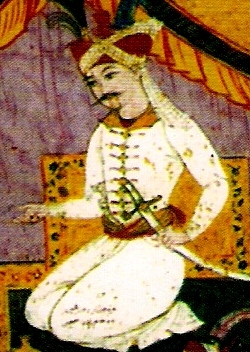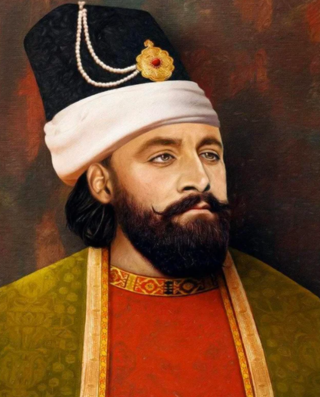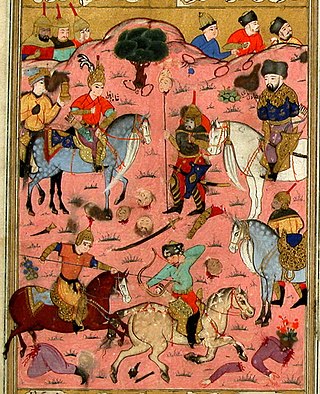
Soltan Hoseyn was the Safavid shah of Iran from 1694 to 1722. He was the son and successor of Shah Suleiman.

The Karabakh Khanate was a khanate under Iranian and later Russian suzerainty, which controlled the historical region of Karabakh, now divided between modern-day Armenia and Azerbaijan. In terms of structure, the Karabakh Khanate was a miniature version of Iranian kingship. The administrative and literary language in Karabakh until the end of the 19th century was Persian, with Arabic being used only for religious studies, despite the fact that most of the Muslims in the region spoke a Turkic dialect.
The Russo-Persian Wars or Russo-Iranian Wars were a series of conflicts between 1651 and 1828, concerning Persia and the Russian Empire. Russia and Persia fought these wars over disputed governance of territories and countries in the Caucasus. The main territories disputed were Aran, Georgia and Armenia, as well as much of Dagestan – generally referred to as Transcaucasia – and considered part of the Safavid Iran prior to the Russo-Persian Wars. Over the course of the five Russo-Persian Wars, the governance of these regions transferred between the two empires. Between the Second and Third Russo-Persian Wars, there was an interbellum period in which a number of treaties were drawn up between the Russian and the Persian Empires, as well as between both parties and the Ottoman Empire. Ottoman interest in these territories further complicated the wars, with both sides forming alliances with the Ottoman Empire at different points throughout the wars. Following the Treaty of Turkmenchay, which concluded the Fifth Russo-Persian War, Persia ceded much of its Transcaucasian territory to the Russian Empire.

Khalilullah I, also known as Sultan-Khalil (سلطان-خلیل), was the Shirvanshah from 1418 to 1465. He was the son and successor of Ibrahim I. He was succeeded by his son Farrukh Yasar.

The Ganja Khanate was a khanate under Iranian suzerainty, which controlled the town of Ganja and its surroundings, now located in present-day Azerbaijan.

Farrukh Yasar was the last independent Shirvanshah of Shirvan (1465–1500). In 1500, the first Safavid ruler, Ismail I, decisively defeated and killed Farrukh Yasar during his conquest of the area. Descendants of Farrukh Yasar continued to rule Shirvan under Safavid suzerainty, until 1538, when Ismail's son and successor Tahmasp I appointed its first Safavid governor, and made it a fully functioning Safavid province.

Ismail II was the third shah of Safavid Iran from 1576 to 1577. He was the second son of Tahmasp I with his principal consort, Sultanum Begum. On the orders of Tahmasp, Ismail spent twenty years imprisoned in Qahqaheh Castle; whether for his recurrent conflicts with the realm's influential vassals, or for his growing popularity with the Qizilbash tribes, resulting in Tahmasp becoming wary of his son's influence.
Ibrahim Khalil Khan Javanshir was the second khan of the Karabakh Khanate from the Javanshir family. He was the son and successor of Panah-Ali khan Javanshir.

Panah Ali Khan Javanshir was the founder and first ruler of the Karabakh Khanate under Persian suzerainty.

The Shirvanshahs were the rulers of Shirvan from 861 to 1538. The first ruling line were the Yazidids, an originally Arab and later Persianized dynasty, who became known as the Kasranids. The second ruling line were the Darbandi, distant relatives of the Yazidids/Kasranids.

Shaykh Junayd was the son of Shaykh Ibrahim, grandson of Shaykh Ali Safavi, father of Shaykh Haydar and grandfather of the founder of Safavid dynasty, Shah Ismail I. After the death of his father, he assumed the leadership of the Safaviyya from 1447–1460.

"Gazikumukh Shamkhalate" is a term introduced in Russian-Dagestan historiography starting from the 1950s–60s to denote the Kumyk state that existed on the territory of present-day Dagestan in the period of the 8th to 17th centuries with the capital in Gazi-Kumukh, and allegedly disintegrated in 1642. However, In the 16th century's Russian archival sources Tarki is stated to be the "capital of Shamkhalate" and "the city of Shamkhal", while "Kazi-Kumuk" is mentioned as a residence. These facts contradict "1642 disintegration" date. Moreover, there is absolutely no source before the 1950s containing the term "Gazikumukh Shamkhalate" or a statement that Gazi-Kumukh had ever been the capital of Shamkhalate. Historically, Shamkhalate is widely described as Tarki Shamkhalate or just Shamkhalate.
Gazikumukh Khanate was a Lak state that was established in present-day Dagestan after the disintegration of Gazikumukh Shamkhalate in 1642. Its peoples included various Lezgin tribes and Avars.

Ibrahim Mirza, Solṭān Ebrāhīm Mīrzā, in full Abu'l Fat'h Sultan Ibrahim Mirza was a Persian prince of the Safavid dynasty, who was a favourite of his uncle and father-in-law Shah Tahmasp I, but who was executed by Tahmasp's successor, the Shah Ismail II. Ibrahim is now mainly remembered as a patron of the arts, especially the Persian miniature. Although most of his library and art collection was apparently destroyed by his wife after his murder, surviving works commissioned by him include the manuscript of the Haft Awrang of the poet Jami which is now in the Freer Gallery of Art in Washington D.C.
Fatali Khan or Fath Ali Khan of Quba was a khan of the Quba Khanate (1758–1789) who also managed to dominate the Derbent, Baku, Talysh and Shirvan Khanates, as well as the Salyan Sultanate during much of his reign.
Farrukh Yassar II was the brief 42nd shah of Shirvan.

Abu'l Ghazi Sultan Alqas Mirza, better known as Alqas Mirza, was a Safavid prince and the second surviving son of king (shah) Ismail I. In early 1546, with Ottoman help, he staged a revolt against his brother Tahmasp I, who was king at the time.
Muhammad Husayn Khan Mushtaq, was the third khan of Shaki. He was described as a courageous but ruthless man by Abbasgulu agha Bakikhanov.

Sultan Murad was the last sultan of the Aq Qoyunlu from 1497 to 1508. After losing his kingdom to the Safavid Shah Ismail I, he fled to Diyar Bakr, where he was eventually killed by Shah Ismail's Qizilbash soldiers at the end of 1514.

The Battle of Mollahasanli took place on 28 November 1578 during the Ottoman–Safavid War (1578–1590) in the town of Mollahasanli on the banks of the Agsu River in Shirvan. The Safavid army, under the command of the Crown Prince Hamza Mirza, defeated the army of the Ottoman ally, the Crimean Khan, under the command of the kalga Adil Giray. Adil Giray himself was taken














